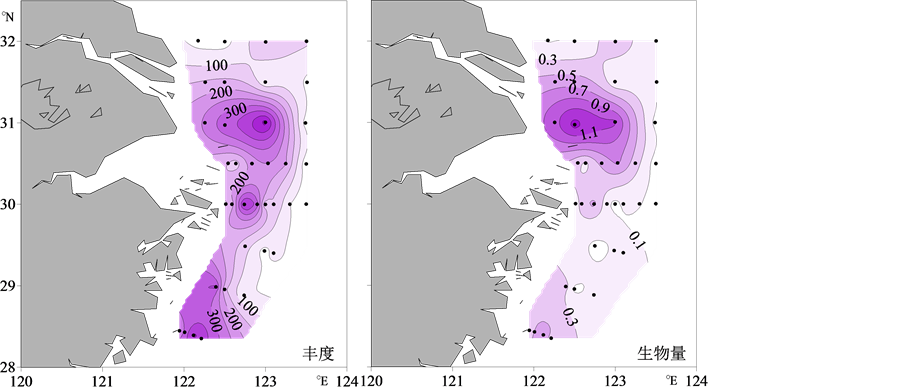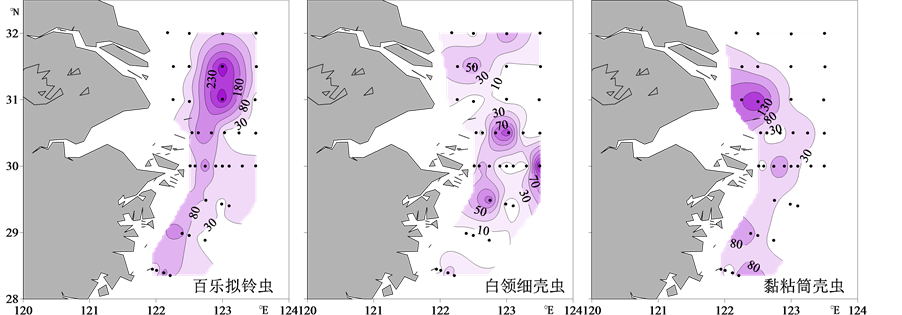Advances in Marine Sciences
Vol.02 No.03(2015), Article ID:16076,7
pages
10.12677/AMS.2015.23007
Distribution of Tintinnids (Ciliophora, Tintinnida) in the Changjiang Estuary and Adjacent Areas in Spring
Ying Yu1, Xuan Luo2, Cuixia Zhang3, Wuchang Zhang2*
1Laboratory of Fisheries Resources and Ecological Environment, Tianjin Bohai Sea Fisheries Research Institute, Tianjin
2Key Laboratory of Marine Ecology and Environmental Sciences, Institute of Oceanology, Chinese Academy of Sciences, Qingdao Shandong
3College of Marine and Environmental Sciences, Tianjin University of Science & Technology, Tianjin
Email: *wuchangzhang@163.com
Received: Aug. 27th, 2015; accepted: Sep. 15th, 2015; published: Sep. 23rd, 2015
Copyright © 2015 by authors and Hans Publishers Inc.
This work is licensed under the Creative Commons Attribution International License (CC BY).
http://creativecommons.org/licenses/by/4.0/



ABSTRACT
We investigated the abundance and biomass of tintinnids in the Changjiang Estuary and adjacent areas in spring of 2010. The average abundance of tintinnids was 226 ± 243 ind/L, ranging from 0 to 1362 ind/L. The average biomass of tintinnids was 0.54 ± 0.86 µg C/L, ranging from 0.00 to 5.97 µg C/L. High value areas of tintinnid abundance and biomass were mainly distributed in the middle area off the Changjiang Estuary. Tintinnids tended to accumulate in the surface layer. Twenty two tintinnid species were identified, 11 of which were in genus Tintinnopsis. The most dominant species were Tintinnopsis beroidea, Tintinnidium mucicola and Stenosemella nivalis. The average Shannon index and Pielou index were 1.05 ± 0.59 and 0.66 ± 0.33, respectively. The Shannon index and Pielou index were higher in the area off the Changjiang Estuary.
Keywords:Tintinnid, Abundance, Biomass, Community Structure, Changjiang Estuary

2010年春季长江口及邻近海域砂壳纤毛虫的 分布特点
于莹1,罗璇2,张翠霞3,张武昌2*
1天津渤海水产研究所渔业资源与生态环境研究室,天津
2中国科学院海洋研究所海洋生态与环境科学重点实验室,山东 青岛
3天津科技大学海洋与环境学院,天津
Email: *wuchangzhang@163.com
收稿日期:2015年8月27日;录用日期:2015年9月15日;发布日期:2015年9月23日

摘 要
于2010年春季(5月)在长江口及邻近海域进行砂壳纤毛虫丰度和生物量的调查。砂壳纤毛虫的丰度范围为0~1362 ind/L,平均丰度为226 ± 243 ind/L;砂壳纤毛虫的生物量范围为0.00~5.97 μg C/L,平均生物量为0.54 ± 0.86 μg C/L。表、中和底层砂壳纤毛虫丰度和生物量的高值区一般分布在长江口外海域的中部;砂壳纤毛虫丰度和生物量均在表层达到最高值,随水深增加明显降低。共鉴定出砂壳纤毛虫9属22种,其中拟铃虫属(Tintinnopsis)种类最多。主要优势种为百乐拟铃虫(Tintinnopsis beroidea)、黏粘筒壳虫(Tintinnidium mucicola)和白领细壳虫(Stenosemella nivalis)。砂壳纤毛虫群落Shannon指数的平均值为1.05 ± 0.59,Pielou指数的平均值为0.66 ± 0.33。砂壳纤毛虫群落水体Shannon指数和Pielou指数的高值区主要分布在长江口外海域。
关键词 :砂壳纤毛虫,丰度,生物量,群落特征,长江口

1. 引言
砂壳纤毛虫是一类微小(10~200 μm)、具壳的单细胞原生动物,隶属于纤毛门(Ciliophora),旋毛纲(Spirotrichea),砂壳目(Tintinnida) [1] ;根据壳上有无外来颗粒,砂壳纤毛虫分为黏着壳和透明壳两大类[2] 。作为海洋微型浮游动物的重要组成部分,砂壳纤毛虫主要摄食pico-(0.2~2 μm)和nano-级(2~20 μm)浮游生物,同时被meso-级(200 μm~2 mm)浮游动物和鱼类幼体等所摄食,将微食物网和经典食物链有效地链接起来[3] [4] ,在海洋浮游生态系统中发挥重要的媒介作用。
长江口是我国最大的河口,长江巨大的径流及泥沙输入对长江口及邻近海域的水文条件、营养盐及浮游植物的分布产生巨大的影响[5] -[7] 。Chiang等[8] 和Yu等[9] 发现纤毛虫的分布与长江径流有重要的关系。本文报道2010年春季长江口及邻近海域砂壳纤毛虫丰度和生物量的分布特点及群落特征,为该海区浮游生态系统的研究提供背景数据。
2. 材料与方法
于2010年春季(5月7日~5月19日)在长江口及邻近海域进行浮游纤毛虫的调查,在受长江径流影响的海域及其邻近海域设置8个断面(Da、Db、Dc、Ra、Rb、Za、Zb及Zc)共36个站位(图1),水深范围为12~70 m。在各站位分表层、中层和底层采水,每层取1 L水样装入塑料样品瓶内,用Lugol’s液固定,终浓度1%。
样品分析按照Utermöhl的方法[10] 进行,自然沉淀至少48 h,用虹吸管将水样上层清液小心吸出,剩余约150 mL,于阴凉处保存。取16 mL放于沉降杯内,在Olympus IX71倒置显微镜下100倍或400倍镜检。测量砂壳纤毛虫肉体的体长、体宽,按最接近的几何形状(如柱体、球体和锥体)计算体积。生物量由体积乘转换系数 (0.19 pgC/µm3) [11] 得来。根据文献[12] -[15] 鉴定种类。

Figure 1. Location of the sampling stations, the contour line indicates the water depth (m)
图1. 调查站位图,等值线为水深(m)
根据徐兆礼和陈亚瞿 [16] 的公式计算优势度(Y),公式如下:
 ,
,
式中,ni为第i种的个体数;N为总个体数;fi为第i种在各个站位出现的频率。
砂壳纤毛虫群落的多样性采用Shannon指数( ) [17] ,均匀度采用Pielou指数(J) [18] ,其公式分别如下:
) [17] ,均匀度采用Pielou指数(J) [18] ,其公式分别如下:
 ,
,  ,
,
式中,S为物种种类数;Pi为第i种的个体数与总个体数的比值。
3. 结果
3.1. 丰度和生物量
砂壳纤毛虫的丰度范围为0~1362 ind/L,最大值出现在Db-7站的表层,平均丰度为226 ± 243 ind/L;砂壳纤毛虫的生物量范围为0.00~5.97 μg C/L,最大值出现在Db-7站的表层,平均生物量为0.54 ± 0.86 μg C/L。
3.1.1. 表层
表层砂壳纤毛虫主要分布在调查海域的北部,其丰度的高值区主要分布在长江口外Db断面的中部(Db-7站)及杭州湾外Ra断面的近岸海区(Ra-14站) (图2)。Db-7站百乐拟铃虫(Tintinnopsis beroidea)和钟状网纹虫(Favella campanula)丰度较高,分别为643和444 ind/L,其丰度之和占该站砂壳纤毛虫总丰度的80%;Ra-14站百乐拟铃虫和根状拟铃虫(Tintinnopsis radix)丰度较高,分别为616和332 ind/L,其丰度之和占该站砂壳纤毛虫总丰度的83%。
表层砂壳纤毛虫生物量高值区的分布与丰度类似,主要分布在Db-7站和Ra-14站(图2)。Db-7站钟状网纹虫(Favella campanula)和根状拟铃虫生物量较高,分别为3.66和1.27 μg C/L,其生物量之和占该站砂壳纤毛虫总生物量的83%;Ra-14站根状拟铃虫和百乐拟铃虫生物量较高,分别为1.97和0.78 μg C/L,其生物量之和占该站砂壳纤毛虫总生物量的72%。
3.1.2. 中层
中层砂壳纤毛虫主要分布在调查海域的北部,其丰度的高值区主要分布在长江口外Db、Dc断面的中部(Db-7站和Dc-10站) (图3)。Db-7站百乐拟铃虫和钟状网纹虫丰度较高,分别为456和277 ind/L,其丰度之和占该站砂壳纤毛虫总丰度的79%;Dc-10站黏粘筒壳虫(Tintinnidium mucicola)丰度最高(464 ind/L),其丰度占该站砂壳纤毛虫总丰度的74%。
中层砂壳纤毛虫生物量的高值区主要分布在长江口外Db断面的中部(Db-7站) (图3)。Db-7站钟状网纹虫和根状拟铃虫生物量较高,分别为2.28和1.06 μg C/L,其生物量之和占该站砂壳纤毛虫总生物量的85%。
3.1.3. 底层
底层砂壳纤毛虫丰度的高值区主要分布在长江口外Dc断面的中部(Dc-11站)、杭州湾外Rb断面(Rb-21

Figure 2. Horizontal distribution of tintinnid abundance (ind/L) and biomass (μg C/L) in the surface layer
图2. 表层砂壳纤毛虫丰度(ind/L)和生物量(μg C/L)的水平分布

Figure 3. Horizontal distribution of tintinnid abundance (ind/L) and biomass (μg C/L) in the middle layer
图3. 中层砂壳纤毛虫丰度(ind/L)和生物量(μg C/L)的水平分布
站)及浙江沿岸Zc断面的近岸海区(Zc-35站) (图4)。Dc-11站百乐拟铃虫丰度最高(292 ind/L),其丰度占该站砂壳纤毛虫总丰度的62%;Rb-21站黏粘筒壳虫丰度最高(291 ind/L),其丰度占该站砂壳纤毛虫总丰度的70%;Zc-35站百乐拟铃虫和白领细壳虫(Stenosemella nivalis)丰度较高,分别为281和116 ind/L,其丰度之和占该站砂壳纤毛虫总丰度的96%。
底层砂壳纤毛虫生物量的高值区主要分布在长江口外Dc断面的中部(Dc-10站) (图4)。Dc-10站根状拟铃虫和纤弱拟铃虫(Tintinnopsis gracilis)生物量较高,分别为0.59和0.46 μg C/L,其生物量之和占该站砂壳纤毛虫总生物量的76%。
3.2. 垂直分布
砂壳纤毛虫丰度和生物量均在表层达到最高值,随水深增加明显降低。表、中和底层砂壳纤毛虫的平均丰度分别为266 ± 329,237 ± 207和169 ± 139 ind/L;表、中和底层砂壳纤毛虫的平均生物量分别为0.74 ± 1.22,0.56 ± 0.71和0.30 ± 0.33 μg C/L。
3.3. 种类组成
共鉴定出砂壳纤毛虫9属22种(表1),其中拟铃虫属 (Tintinnopsis)种类最多,为11种。黏着壳类砂壳纤毛虫共16种,透明壳类砂壳纤毛虫共6种。
主要优势种为百乐拟铃虫、黏粘筒壳虫和白领细壳虫,其优势度分别为0.26、0.03和0.03。百乐拟铃虫分布广泛,出现的频率为97.1% (图5),最大丰度为643 ind/L出现在Db-7站表层;白领细壳虫分布没有明显的规律,出现的频率为61.8% (图5),最大丰度为334 ind/L,出现在Rb-26站中层;黏粘筒壳虫主要分布在近岸,出现的频率为55.9% (图5),最大丰度为464 ind/L,出现在Dc-10站中层。
3.4. 群落特征
砂壳纤毛虫群落Shannon指数的平均值为1.05 ± 0.59,最大值为2.16,出现在Dc-10站;Pielou指数的平均值为0.66 ± 0.33,最大值为1.00,出现在Da-1、Db-6、Dc-12及Za-29、Zb-32站。
砂壳纤毛虫群落水体Shannon指数的高值区主要出现在长江口外海域,且基本呈现由近岸向远岸降低的趋势(图6);水体Pielou指数与Shannon指数的水平分布模式大体类似,另外,在调查海域的南部远

Figure 4. Horizontal distribution of tintinnid abundance (ind/L) and biomass (μg C/L) in the bottom layer
图4. 底层砂壳纤毛虫丰度(ind/L)和生物量(μg C/L)的水平分布
Table 1. List of tintinnid species
表1. 砂壳纤毛虫种类名录

Figure 5. Horizontal distribution of the abundance (ind/L) of Tintinnopsis beroidea, Tintinnidium mucicola and Stenosemella nivalis
图5. 百乐拟铃虫、黏粘筒壳虫和白领细壳虫水体丰度(ind/L)的水平分布

Figure 6. Horizontal distribution of water column integrated Shannon index and Pielou index of tintinnid community
图6. 砂壳纤毛虫群落水体Shannon指数和Pielou指数的水平分布
岸海区也有一个Pielou指数的高值区(图6)。
4. 讨论
4.1. 砂壳纤毛虫种类
本研究共鉴定出砂壳纤毛虫22种,与其它近岸海区同季节相比,种类较多。如莱州湾[19] 、桑沟湾[20] 和胶州湾[21] ,鉴定出砂壳纤毛虫的种类分别为5、5及13种。
根据Dolan等[22] 的研究,砂壳纤毛虫各属可分为广布型(Cosmopolitan)、近岸浅海型(Neritic)、暖水型(Warm water)、北半球型(Boreal)和南半球型(Austral)5种类型。本研究的9属砂壳纤毛虫中,有2属为广布型(类铃虫属Codonellopsis和真铃虫属Eutintinnus),6属为近岸浅水型(网纹虫属Favella、薄铃虫属Leprotintinnus、类杯虫属Metacylis、细壳虫属Stenosemella、拟铃虫属Tintinnopsis和筒壳虫属Tintinnidium),1属为暖水型(波膜虫属Undella)。波膜虫属在东海只在8月出现,丰度较低[23] 。Li等[23] 发现的其他暖水型种类在本海区没有发现,说明本海区的砂壳纤毛虫群落受外海影响较小,是典型的近岸群落。
4.2. 水平分布
由于本研究中砂壳纤毛虫群落是典型的近岸群落,其水平分布受河口复杂的混合过程影响较大,表现出明显的斑块分布。由于本研究缺乏温度盐度等资料,所以只能做非常初步的推测。
各层砂壳纤毛虫丰度和生物量一般在长江口外海域较高,这与其它河口区的分布模式类似。在Damariscotta River河口[24] 和Rhone River河口[25] ,砂壳纤毛虫丰度在河口附近较高。这可能与饵料的可利用性有关。长江淡水输入带来大量的营养盐,刺激浮游植物大量生长 [6] [7] ,从而为砂壳纤毛虫提供丰富的饵料。
本研究中砂壳纤毛虫丰度和生物量一般出现在长江口外海域的中部,并不在近岸和更远。砂壳纤毛虫在近岸丰度低可能因为这个区域盐度太低,不适合砂壳纤毛虫生长。另外,长江径流携带大量的泥沙入海,造成长江入海口处悬浮泥沙浓度较高[26] ,而河口处较高的浊度可能阻碍砂壳纤毛虫的入侵,高浓度的颗粒物可能影响砂壳纤毛虫的滤食行为[27] ,从而造成河口处砂壳纤毛虫丰度和生物量较低。在离长江口更远的地方,水体混合减弱,开始层化,而层化水体不利于砂壳纤毛虫生长[9] 。
基金项目
国家自然科学基金41576164,国家自然科学基金U1406403,国家重点基础研究发展计划2011CB409804,2010CB428705。
文章引用
于 莹,罗 璇,张翠霞,张武昌, (2015) 2010年春季长江口及邻近海域砂壳纤毛虫的分布特点
Distribution of Tintinnids (Ciliophora, Tintinnida) in the Changjiang Estuary and Adjacent Areas in Spring. 海洋科学前沿,03,45-52. doi: 10.12677/AMS.2015.23007
参考文献 (References)
- 1. Lynn, D.H. (2008) Ciliated protozoa: Characterization, classification, and guide to the literature. Springer, Dor-drecht.
- 2. Capriulo, G.M., Gold, K. and Okubo, A. (1982) Evolution of the lorica in tintinnids: A possible selective advantage. Annales de l’Institut Oceanographique, 58, 319-323.
- 3. Pierce, R.W. and Turner, J.T. (1992) Ecology of planktonic ciliates in marine food webs. Reviews in Aquatic Sciences, 6, 139-181.
- 4. Azam, F., Fenchel, T., Field, J.G., Gray, J.S., Meyer-Reil, L.A. and Thingstad, F. (1983) The ecological role of water column microbes in the sea. Marine Ecology-Progress Series, 10, 257-263. http://dx.doi.org/10.3354/meps010257
- 5. Zhang, J., Liu, S.M., Ren, J.L., Wu, Y. and Zhang, G.L. (2007) Nutrient gradients from the eutrophic Changjiang (Yangtze River) Estuary to the oligotrophic Kuroshio waters and re-evaluation of budgets for the East China Sea Shelf. Progress in Oceanography, 74, 449-478. http://dx.doi.org/10.1016/j.pocean.2007.04.019
- 6. 吴玉霖, 傅月娜, 张永山, 蒲新明, 周成旭 (2004) 长江口海域浮游植物分布及其与径流的关系. 海洋与湖沼, 35, 246-251.
- 7. 周名江, 颜天, 邹景忠 (2003) 长江口邻近海域赤潮发生区基本特征初探. 应用生态学报, 14, 1031-1038.
- 8. Chiang, K.P., Lin, C.Y., Lee, C.H., Shiah, F.K. and Chang, J. (2003) The coupling of oligotrich ciliate populations and hydrography in the East China Sea: spatial and temporal variations. Deep-Sea Research Part II, 50, 1279-1293. http://dx.doi.org/10.1016/S0967-0645(03)00023-7
- 9. Yu, Y., Zhang, W., Feng, M., Zhao, Y., Zhang, C., Zhou, F. and Xiao, T. (2015) Differences in the Vertical Distribution and Response to Freshwater Discharge between Aloricate Ciliates and Tintinnids in the East China Sea. Journal of Marine Systems. http://dx.doi.org/10.1016/j.jmarsys.2015.02.005
- 10. Utermöhl, H. (1958) Zur vervollkommnung der quantitativen phytoplankton methodik. Mitteilingen der Internationalen Vereinigung fur Theoretische und Angewandte Limnologie, 9, 1-38.
- 11. Putt, M. and Stoecker, D.K. (1989) An experimentally determined carbon: Volume ratio for marine “oligotrichous” ciliates from estuarine and coastal waters. Limnology and Oceanography, 34, 1097-1103. http://dx.doi.org/10.4319/lo.1989.34.6.1097
- 12. 张武昌, 丰美萍, 于莹, 张翠霞, 肖天 (2012) 砂壳纤毛虫图谱. 科学出版社, 北京.
- 13. 尹光德 (1952) 胶州湾砂壳纤毛虫之初步调查. 山东大学学报, 2, 36-56.
- 14. Nie, D.S. and Cheng, P.S. (1947) Tintinnoinea of the Hainan region. Contributions from the Biological Laboratory of the Science Society of China: Zoological Series, 16, 41-86.
- 15. Kofoid, C.A. and Campbell, A.S. (1929) A conspectus of the marine fresh-water ciliate belonging to the suborder tintinnoinea, with descriptions of new species principally from the Agassiz expedition to the eastern tropical Pacific 1904-1905. University of California Press, Oakland.
- 16. 徐兆礼, 陈亚瞿 (1989) 东黄海秋季浮游动物优势种聚集强度与鲐鲹渔场的关系. 生态学杂志, 4, 13-15.
- 17. Shannon, C.E. and Weaver, W. (1949) The mathematical theory of communication. University of Illinois Press, Urbana.
- 18. Pielou, E.C. (1966) The measurement of diversity in different types of biological collections. Journal of Theoretical Biology, 13, 131-144. http://dx.doi.org/10.1016/0022-5193(66)90013-0
- 19. 陈雪, 张武昌, 吴强, 栾青杉, 肖天 (2014) 莱州湾大型砂壳纤毛虫群落季节变化. 生物多样性, 5, 649-657.
- 20. 于莹, 张武昌, 蒋增杰, 赵苑, 丰美萍, 李海波, 肖天 (2013) 桑沟湾浮游纤毛虫丰度和生物量分布的季节变化. 海洋学报(中文版), 3, 215-224.
- 21. 于莹, 张武昌, 赵楠, 孙晓霞, 张翠霞, 丰美萍, 肖天 (2011) 胶州湾浮游纤毛虫丰度和生物量的周年变化. 海洋与湖沼, 5, 690-701.
- 22. Dolan, J.R., Montagnes, D.J.S., Agatha, S., Coats, D.W. and Stoecker, D.K. (2012) The biology and ecology of tintinnid ciliates: Models for marine plankton. Wiley-Blackwell, Oxford.
- 23. Li, H., Zhao, Y., Chen, X., Zhang, W., Xu, J., Li, J. and Xiao, T. (2015) Interaction between neritic and warm water tintinnids in surface waters of East China Sea. Deep Sea Research II, In Press. http://dx.doi.org/10.1016/j.dsr2.2015.06.008
- 24. Sanders, R.W. (1987) Tintinnids and other microzooplank-ton—Seasonal distributions and relationships to resources and hydrography in a Maine estuary. Journal of Plankton Research, 9, 65-77. http://dx.doi.org/10.1093/plankt/9.1.65
- 25. Christaki, U., Courties, C., Joux, F., Jeffrey, W.H., Neveux, J. and Naudin, J.J. (2009) Community structure and trophic role of ciliates and heterotrophic nanoflagellates in Rhone River diluted mesoscale structures (NW Mediterranean Sea). Aquatic Microbial Ecology, 57, 263-277. http://dx.doi.org/10.3354/ame01339
- 26. 朱建荣 (2004) 长江口外海区叶绿素a浓度分布及其动力成因分析. 中国科学(D辑: 地球科学), 8, 757-762.
- 27. Urrutxurtu, I. (2004) Seasonal succession of tintinnids in the Nervion River estuary, Basque Country, Spain. Journal of Plankton Research, 26, 307-314. http://dx.doi.org/10.1093/plankt/fbh034
